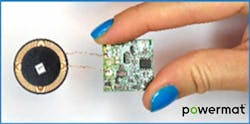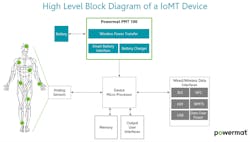Cut the Cables on Medical Devices to Improve Patient Mobility and Care
At a Glance:
- A patient’s experience shapes her perspective on wireless power solutions for medtech.
- Learn how IoT of medical technology (IoMT) is revolutionizing the patient experience and care.
- Itay Sherman, chief technology officer at Powermat, discusses why portability should be tied to ease of use and how his company leverages the benefits of IoMT to achieve this goal.
Tori Bentkover is enthusiastic about the progress of wireless charging technologies for medical devices. Not because she is a public relations professional representing a firm that develops the technology, but because she knows firsthand what a difference it can make in a patient’s hospital stay.
“For me, physically going to unplug a monitor from the wall was always unnerving,” said Bentkover, who suffered for seven years with the debilitating effects of ulcerative colitis, an inflammatory bowel disease, before undergoing surgery to have her colon removed in 2017.
“There’s always hesitancy when you have wires coming in and out of you, because you don’t want to ruin anything or do anything to hurt your recovery,” she said.
Bentkover’s hospital experience highlights the routine challenges and limitations patients face. Her ileostomy—a surgery that connects the lowest part of your small intestine to the outside of your body—was performed in three stages. The first part involved removing the colon and rectum. “The best part of is waking up and actually feeling better because the inflamed organ is no longer in your body,” said Bentkover.
Yet, while she was healing internally, she wore an external ostomy bag. “It’s not glamorous,” said Bentkover. “During the second part of the procedure, they form what’s called the J-pouch from your small intestine and that becomes your new colon. And then you continue the process of healing a little bit. The third surgery is when they connect everything and put it all back inside.”
Even before the surgery, there were times when Bentkover ended up in hospital due to iron deficiency and dehydration. During these visits she would invariably be hooked up to IV pumps and monitors that affected her mobility and infringed on her independence.
Improving the Patient Experience
Reflecting on intermittent hospital stays, Bentkover said that not having to unplug cables and wrap them around equipment and physically get to the bathroom when there was a sense of urgency would have been helpful. “As I learn about how companies like Powermat and hospitals are planning for their futures through wireless power, I think it can go a long way in improving the patient experience,” said Bentkover.
Antenna Group, the public relations firm Bentkover works for, represents Powermat Technologies, a wireless power solutions developer of inductive charging technology.
Over the past few years, Powermat has been expanding wireless power capabilities into IoT, robotics and automotive segments, and has joined the growing fold of manufacturers that emphasize human-centric design for connected medical devices.
MarketandMarkets reports growth in the medical devices market is driven by the need for cost-containment in healthcare delivery, but is also attributed to rising focus on active patient engagement and patient-centric care delivery. Globally, the IoT medical devices market is forecasted to reach $92.4 billion by 2026 from $26.5 billion in 2021, according to the B2B research group.
Power to the Battery
Powermat’s chief technology officer, Itay Sherman, echoed this trend when he explained that in the IoT of medical technology (IoMT) segment, the benefits of portability are tied to ease of use for the end-user. Powermat’s MCU-less system architecture developed for medical devices does not contain controllers, but work efficiently and safely with the use of a passive receiver.
Sherman pointed out that standard wireless power solutions, such as mobile handsets, include a controller in the transmitter, as well as a controller on the receiver side. “The aim of these two controllers is to communicate with each other in order to control the power transfer between the two devices,” he explained.
In more advanced solutions, the controller may provide wireless power but also control the battery charge. “But when it comes to creating solutions that are most suitable for power-sensitive, size-sensitive concepts, a designer would want to simplify the receiver side of the equation,” said Sherman. “We transferred all of the smarts that exist on the receiver side to the controller of the transmitter and this allowed the creation of a receiver that is very simple. It doesn’t have an MCU in it.”
The device consists of mostly passive components, Sherman said, but still provides all of the benefits that come with a complete system. As an example, Powermat’s PMT 100 Wireless Power Solution was designed for small form factor IoT devices for wireless power and with charging in mind, and it is touted for reducing overall wireless power implementation costs by up to 50%. Power transfer is controlled with smart algorithms in the transmitter side, while battery charging is done on the receiver end.
The solution is driven by SmartInductive technology, which Sherman described as “hybrid” because it draws from both inductive and resonance charging effects. Broadly defined, an inductive effect describes the transmission of electrical charges between atoms in a molecule, while a resonance effect describes the transmission of electron pairs between atoms in a molecule.
The trademarked technology is enabled by the advanced transmitter algorithm that controls both power and safety parameters in devices that require up to 300 W of power. By using wireless power for portable and personal medical devices, designers can reduce the size of the battery and embed it into small sensor devices.
An additional advantage is the ease with which one can sanitize devices. “The fact that you can now create a complete steel device, with no input or output ports, makes it way easier to sanitize devices, but also provides much easier charging capability for the devices,” said Sherman. “You just rest the device on its charging pad or connector.”
Enabling IoMT
Building capabilities for scalability comes with challenges, and creating a cost-efficient solution ranks high on the list. “Sometimes it’s very easy to pick the best-in-class device and you’ll get a very robust solution, but it is (a) big and (b) costly,” said Sherman. “We are doing a lot of things in algorithms in software in order to lower costs. Sometimes it could mean not using accurate components.
"We don’t need, for example, to pick coils that are very fine-tuned to specific inductors," he added. "We can tolerate major differences in production of these coils. And we compensate by using the algorithms that are running on the controller. Essentially, software is for free, so we do a little bit more work on the software and thereby optimize the overall cost of the solution.”
If connectivity and interoperability technologies are the enablers in the IoMT ecosystem, then Powermat has made contributions to the design of medical carts, diagnostic instruments and handheld medical devices, as well as wearables and implanted devices such as pacemakers and defibrillators.
Beyond medical design, Powermat has facilitated seamless wireless connectivity that power various products for Duracell, General Motors, Starbucks and AT&T. Cross-industry collaboration and diverting efforts into other segments have helped bridge gaps in creating solutions that provide clinical, operational and, above all, patient value, said Sherman.
Today, Tori Bentkover is grateful for having regained her quality of life. “The hospital setting can be unnerving and dehumanizing, and there are so many studies that show the relationship between hospitals and patient experience and how that helps the recovery and healing process,” she mused.
About the Author

Rehana Begg
Editor-in-Chief, Machine Design
As Machine Design’s content lead, Rehana Begg is tasked with elevating the voice of the design and multi-disciplinary engineer in the face of digital transformation and engineering innovation. Begg has more than 24 years of editorial experience and has spent the past decade in the trenches of industrial manufacturing, focusing on new technologies, manufacturing innovation and business. Her B2B career has taken her from corporate boardrooms to plant floors and underground mining stopes, covering everything from automation & IIoT, robotics, mechanical design and additive manufacturing to plant operations, maintenance, reliability and continuous improvement. Begg holds an MBA, a Master of Journalism degree, and a BA (Hons.) in Political Science. She is committed to lifelong learning and feeds her passion for innovation in publishing, transparent science and clear communication by attending relevant conferences and seminars/workshops.
Follow Rehana Begg via the following social media handles:
X: @rehanabegg
LinkedIn: @rehanabegg and @MachineDesign


